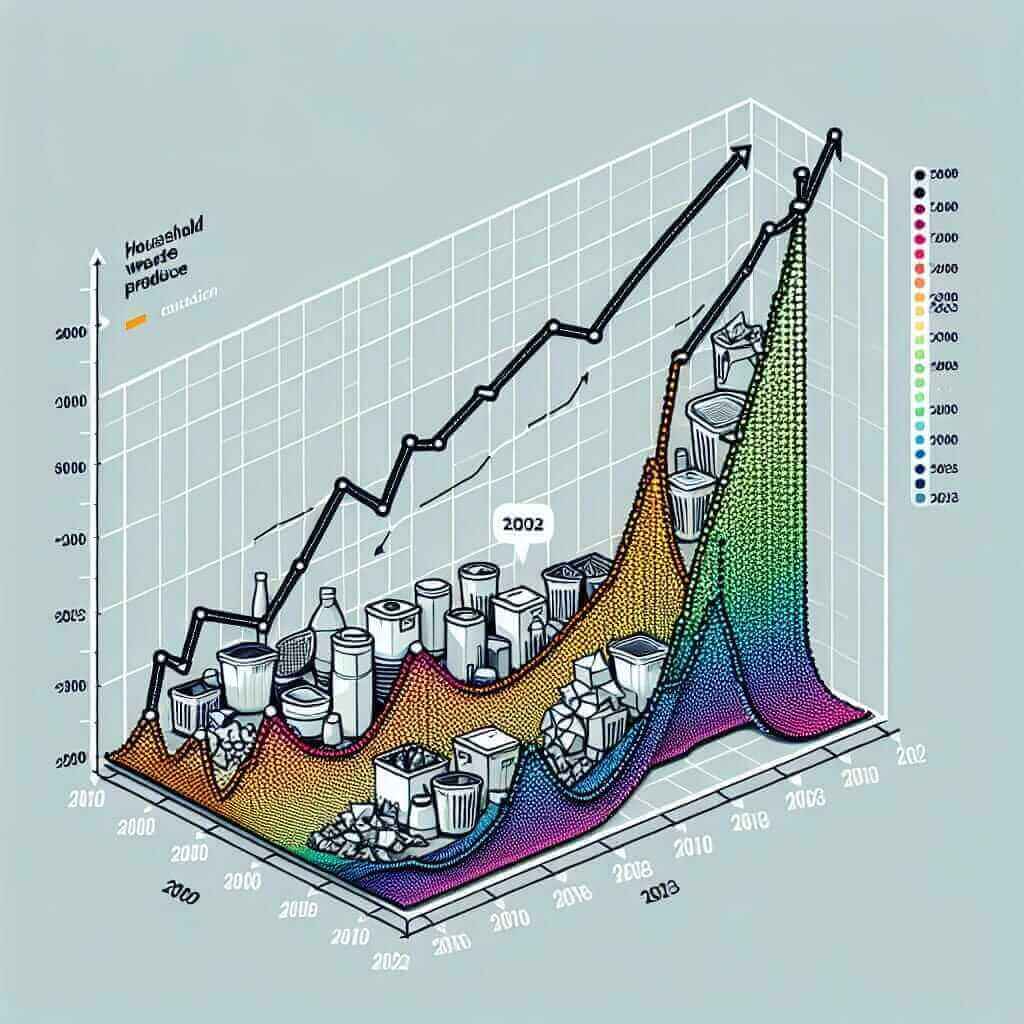The topic of “Trends in Household Waste Production (2000-2023)” is a prominent one in the IELTS Writing Task 1 section. This task frequently requires candidates to describe and analyze data trends, making it essential to understand and articulate the provided information thoroughly. This article will help you master this type of task, providing practical examples, a sample writing task, and tips on relevant vocabulary and grammar.
Example Task and Data Presentation
Task Description
You should spend about 20 minutes on this task.
The chart below shows the trends in household waste production from 2000 to 2023 in three different countries.
Summarize the information by selecting and reporting the main features, and make comparisons where relevant.
Write at least 150 words.
Data Presentation
| Year | Country A (tons) | Country B (tons) | Country C (tons) |
|---|---|---|---|
| 2000 | 400,000 | 300,000 | 500,000 |
| 2005 | 450,000 | 350,000 | 490,000 |
| 2010 | 500,000 | 400,000 | 480,000 |
| 2015 | 550,000 | 420,000 | 470,000 |
| 2020 | 600,000 | 450,000 | 460,000 |
| 2023 | 620,000 | 480,000 | 450,000 |

Analyzing the Task
The given table displays the volume of household waste produced in three countries (Country A, Country B, and Country C) over a 23-year period, from 2000 to 2023. Your goal is to identify and compare the notable trends seen in the data.
Sample Answer
Here’s how you could structure your response:
Introduction:
The provided table illustrates the trends in household waste production in three countries (Country A, Country B, and Country C) from 2000 to 2023. The data suggests varying trends in waste production among these countries over the years.
Overview:
Overall, it is evident that household waste production consistently increased in Country A and Country B, while it gradually decreased in Country C.
Body Paragraph 1:
In 2000, Country A started with the production of 400,000 tons of waste, which rose steadily to 620,000 tons by 2023. Similarly, Country B’s waste production increased from 300,000 tons in 2000 to 480,000 tons in 2023. The incremental growth in waste production in these two countries suggests continuous reliance on waste-producing practices.
Body Paragraph 2:
Conversely, Country C observed an opposite trend. Commencing at 500,000 tons in 2000, the amount of waste produced declined over the years, reaching 450,000 tons by 2023. This trend might indicate effective waste management strategies or reductions in waste generation per household.
Conclusion:
In conclusion, while Country A and Country B have experienced rises in their household waste production over the analyzed period, Country C has managed to reduce its waste production, highlighting different approaches and effectiveness in managing household waste.
Word count: 211 words
Key Tips for Writing Task 1
Vocabulary & Grammar Tips
- Use precise verbs to describe trends: terms like “increase,” “decrease,” “climb,” “drop,” “remain stable,” and “fluctuate”.
- Comparative and superlative forms highlight differences and similarities effectively: e.g., “higher than,” “the highest,” “lower than”.
- Quantifying phrases provide clarity: “a twofold increase,” “a significant drop,” “a slight decrease”.
- Linking words improve coherence: “while,” “although,” “however,” “whereas”.
Sample Vocabulary List
- Fluctuate (verb): movement up and down; ‘The waste production fluctuated between 2000 and 2023.’
- Significant (adj): noteworthy; ‘There was a significant increase in waste production in Country A.’
- Decline (verb/noun): a decrease; ‘A decline was observed in Country C’s waste production.’
- Steadily (adv): gradually over time; ‘The amount of waste produced steadily increased in Country A.’
- Efficient (adj): achieving maximum productivity with minimum wasted effort; ‘Country C’s waste management strategies appear to be efficient.’
- Volume (noun): the amount or quantity; ‘The volume of waste produced in Country B rose significantly.’
- Incremental (adj): increasing gradually by regular degrees; ‘Country B saw incremental growth.’
- Consistently (adv): always acting or behaving in the same way; ‘Country A consistently produced more waste each year.’
- Approach (noun): a way of dealing with something; ‘The approach to waste management differs among these countries.’
- Data (noun): facts and statistics; ‘The data indicates a continuous rise in waste production.’
Conclusion
Successfully handling an IELTS Writing Task 1 involving trends, such as household waste production, requires careful analysis, clear articulation of the main features, and efficient use of comparative language. Focus on summarizing and comparing key trends, utilizing appropriate vocabulary and grammatical structures to achieve a coherent and concise response. Good luck with your practice, and remember, consistency and clarity are the keys to a high band score.